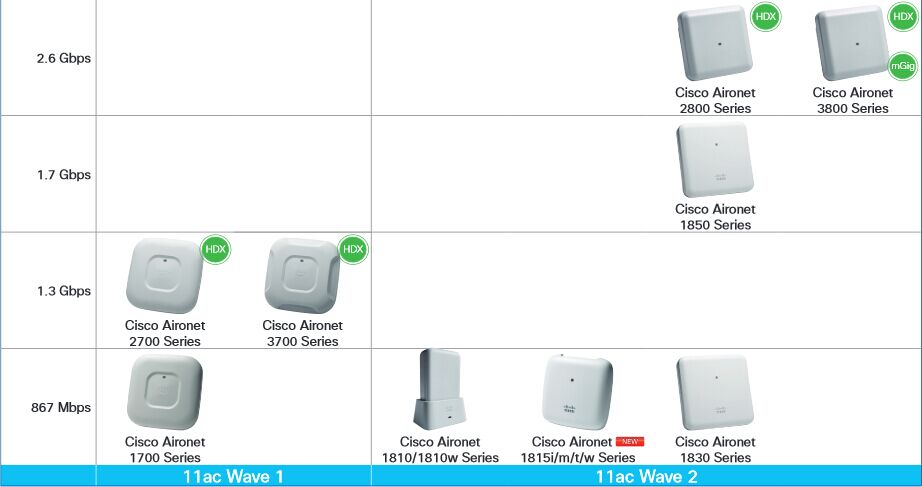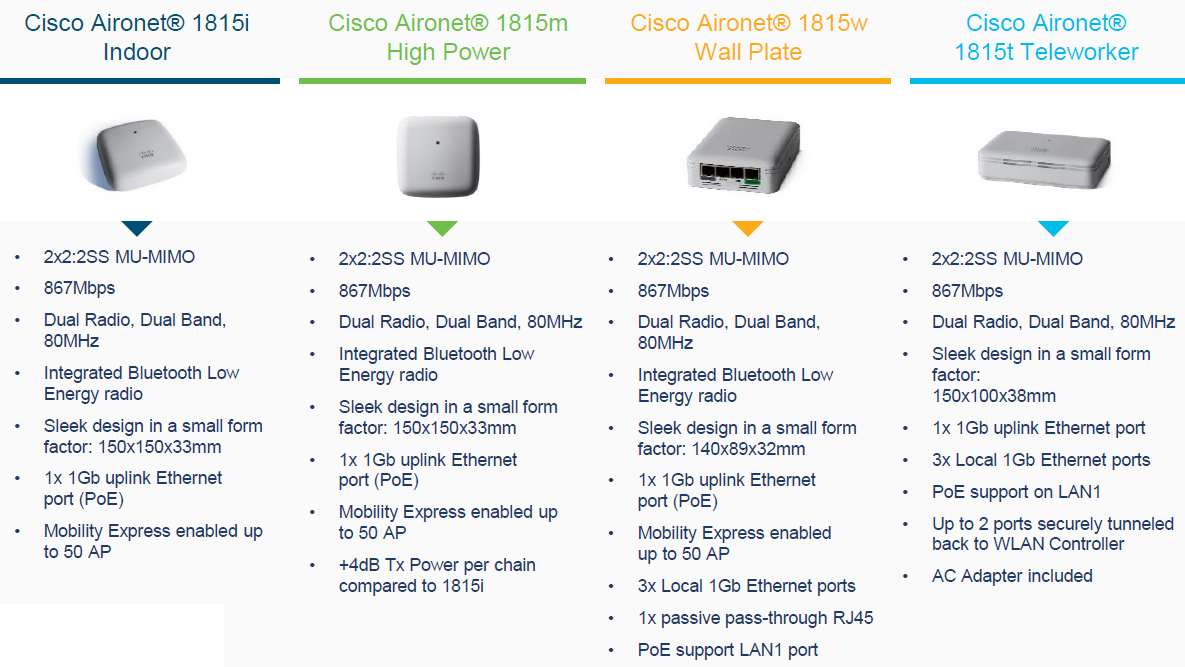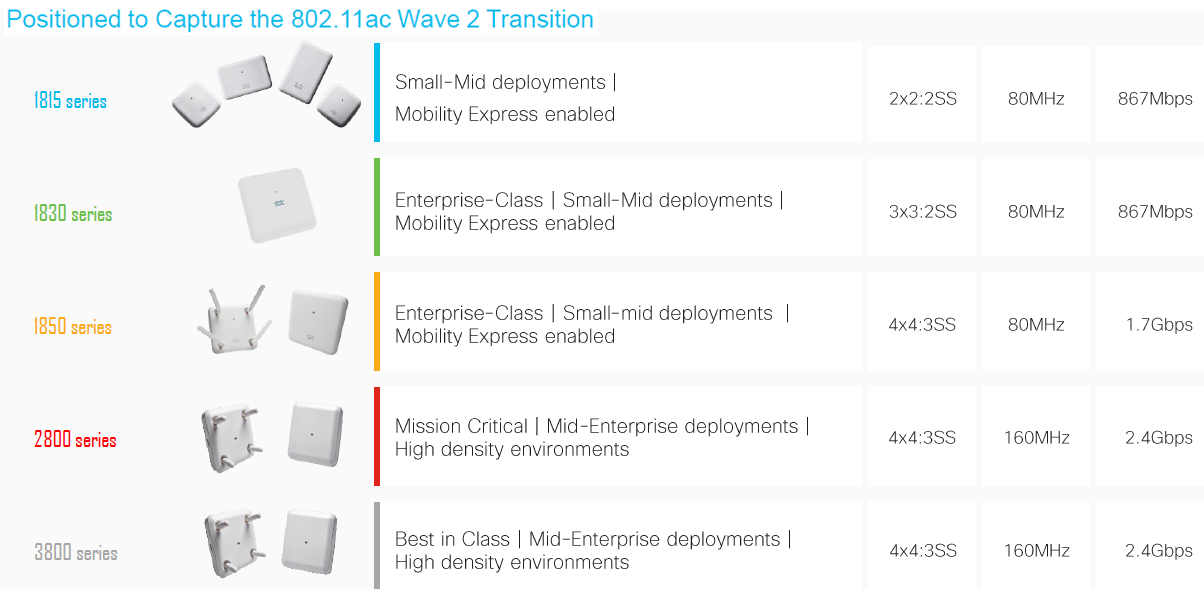
Cisco is providing 5 Series of indoor Access Points to meet customers’ needs of all sizes.
The latest indoor access points are Aironet 3800 Series, Aironet 2800 Series, Aironet 1850 Series, Aironet 1830 Series and Aironet 1815 Series.
The Best Cisco Indoor Access Points
■ Cisco Aironet Indoor Access Points
All models of the Cisco Aironet Indoor Access Points are compatible with the IEEE 802.11n standard; and some models are also compatible with IEEE 802.11ac delivering high-speed and stable wireless LAN environments with a theoretical maximum throughput of between 300 Mbps and 2.6 Gbps. A broad selection of models is available for various installation environments and network requirements.
- Built-in antenna model: These models feature a streamlined body and an integrated LAN/power cable using PoE (Power over Ethernet) for a stylish installation that blends into the office environment.
- External antenna model: These models feature a rigid metal chassis and support a wide range of operating temperatures for use in factories, warehouses and stores where environmental requirements are very strict. A wide selection of antennas is available for these models to suit different installation environments.
There are two types of models for Cisco Aironet Indoor Access Points: Standalone or Mobility Express models, and Controller-based models. The Controller-based models are designed to operate in linkage with the Cisco Wireless Controllers.
■ Highlights
- IEEE 802.11n-compatible (All models)
- IEEE 802.11ac Wave 1-compatible (Cisco Aironet 1700/2700/3700 Series)
- IEEE 802.11ac Wave 2-compatible (Cisco Aironet 1810/1810w/1815i/1815m/1815t/1815w/1830/1850/2800/3800 Series)
- 2.4 GHz/5 GHz dual-band (All models)
- Cisco CleanAir Express (Controller-based models of the Cisco Aironet 1700 Series)
- Cisco CleanAir (Controller-based models of the Cisco Aironet 2700/2800/3700/3800 Series)
- Cisco OfficeExtend (Controller-based models, excluding some models)
- Cisco ClientLink (excluding some models)
- Cisco BandSelect (Controller-based models, excluding some models)
Cisco Aironet Access Points Transition Guide-Indoor Access Points
| 11n | 11ac Wave 1 | 11ac Wave 2 |
| Aironet 600 Series OfficeExtend | — | Cisco Aironet 1810 |
| Aironet 700 Series | — | Cisco Aironet 1815i/1830 Series |
| Aironet 700W Series | — | Cisco Aironet 1815w |
| Aironet 1040 Series | Aironet 1700 Series | Cisco Aironet 1850 Series |
| Aironet 1600 Series | ||
| Aironet 1140 Series | Aironet 2700 Series | Cisco Aironet 2800 Series |
| Aironet 1250 Series | ||
| Aironet 1260 Series | ||
| Aironet 2600 Series | ||
| Aironet 3500 Series | Aironet 3700 Series | Cisco Aironet 3800 Series |
| Aironet 3600 Series |
**Cisco Aironet 3600/3700 Series are planned to support 11ac Wave 2 via addition of a module.
Best in Class 802.11ac Wave 2 Access Point
Cisco Aironet 3800 Series vs. Cisco Aironet 2800 Series

| Cisco Aironet® 3800 Series | Cisco Aironet® 2800 Series |
| Industry leading 4×4 MIMO:3 spatial streams (SS) Wave 2 802.11ac access points | Dual radio, 802.11ac Wave 2, 160 MHz |
| Combined Data Rate of 5.2Gbps | 2 x 5 GHz: 4×4: 3SS supporting
–SU-MIMO / MU-MIMO –Flexible Radio Assignment: 2.4GHz, Dual-5GHz, Wireless Security Monitoring, Wireless Service Assurance*, or Enhanced Location* |
| HDX Technology | Enhanced Location using External Antennas* |
| USB 2.0 | Internal and external antenna models |
| Smart Antenna Connector -2nd Antenna Connector | |
| Gigabit Ethernet and multi-Gigabit Ethernet (1G, 2.5G, 5G)
Modularity: Side Mount Modular |
2 x Gigabit Ethernet with LAG |
* Post-FCS
Get the Best Price for the Cisco Aironet 2800 Access Points
Low Cost High Performance-Cisco Wave 2 Aironet1815 series
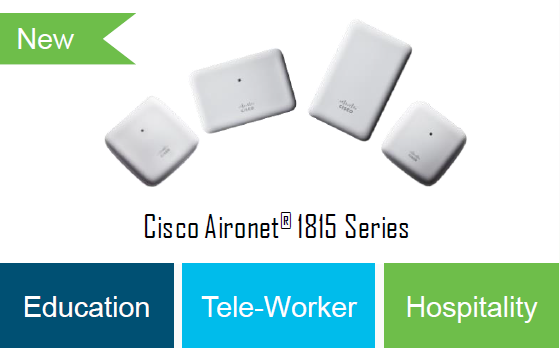
- Comprised of four separate low-cost, sleek APs
- Minimizing total cost of ownership while delivering advanced features
- Easy to deploy and manage with Cisco Mobility Express
- Integrated Bluetooth Low Energy radio*
- Indoor: AIR-AP1815i-x-K9/K9C
- High Power: AIR-AP1815m-x-K9/K9C
- Wall Plate: AIR-AP1815w-x-K9/K9C
- Teleworker: AIR-AP1815t-x-K9/K9C
Aironet1815 Series-Optimize Cost for Capacity or Coverage
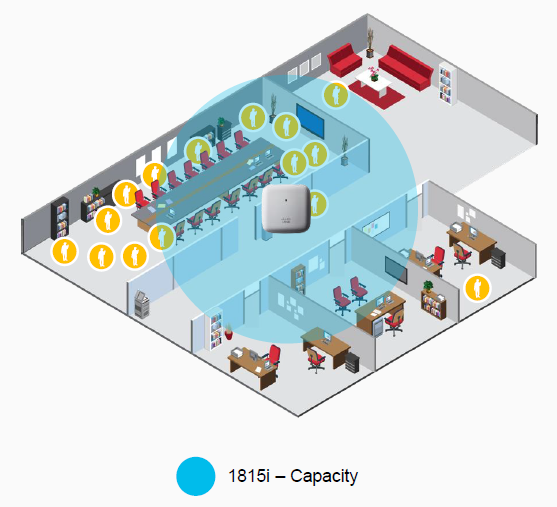
Targeting Asia-Pacific markets to address requirements where the emphasis is often on smaller cells and higher client density
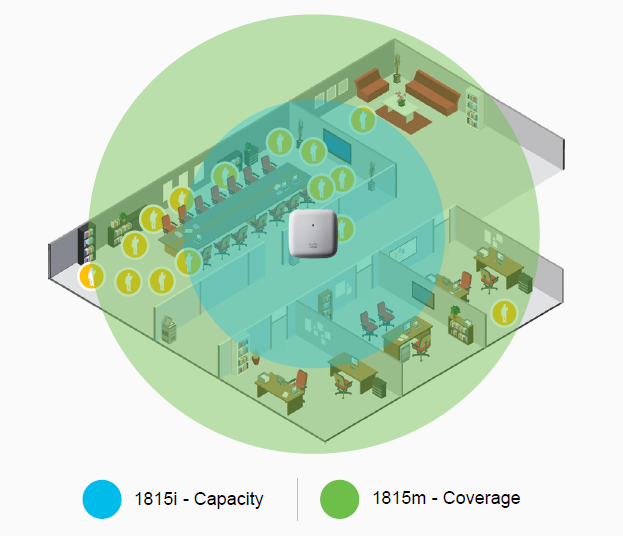
Targeting Asia-Pacific markets to address requirements where the emphasis is often on larger cells and lower client density


